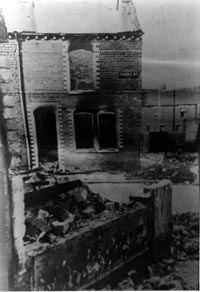13 August 2009 Edition
Remembering the Past: Bombay Street, 1969

Bombay Street was burned to the ground
BY PEADAR WHELANTHE EVENTS of August 1969 will be forever etched on the minds of the nationalist people of the Six Counties.
The mid-1960s saw a Catholic population inspired and encouraged by the Civil Rights movement in the United States demand the right to vote, to housing and to jobs.
The Northern Ireland Civil Rights Association (NICRA) organised marches and protests and demanded equality.
The Unionist government, under Prime Minister Terence O’Neill, deemed a liberal, confronted peaceful protesters and in the
 infamous 5 October march in Duke Street in Derry attacked marchers with batons.
infamous 5 October march in Duke Street in Derry attacked marchers with batons.In November 1968, Civil Rights marchers attempted to stage a demonstration in Armagh City but were denied the right to do so when Ian Paisley and his followers, some armed with guns and cudgels, occupied Market Square. The RUC played its part and turned back the civil rights march.
1969 began as 1968 ended.
BURNTOLLET BRIDGE
Students, under the People’s Democracy banner, marched from Belfast. Setting out on 1 January, they reached Burntollet Bridge, on the outskirts of Derry, on 4 January 1969, where they were confronted by the RUC and loyalist mobs.
In their report into the Burntollet violence, Bowes Egan and Vincent McCormack concluded;
“The attack was organised locally by representatives of the Orange Order and the Special Constabulary, in close collaboration with some members at least of the RUC... Those responsible for organising protection led the march into a trap.”
Eighty-seven people were hospitalised.
That night, the RUC invaded Derry’s Bogside, wrecking houses. Up to 163 Bogsiders received hospital treatment.
April saw the RUC attack on the home of Sammy Devenney in William Street. He was to die as a result of his injuries in July 1969.
The scene was therefore set for the 12 August 1969 when the Apprentice Boys of Derry marched through the City to ‘celebrate’ the lifting of the siege of the city during the Williamite wars of the 1690s.
As the thousands of Apprentice Boys paraded past the Bogside on 12 August, nationalists came on to the streets and, fearing an invasion similar to the January and April incursions, built barricades.
Derry saw two days of intense fighting which wore the RUC out and depleted their reserves.
In support of the besieged Bogsiders, the people of Belfast came on to the streets. In turn, loyalist mobs, working hand in hand with the RUC and ‘B’ Specials, attacked houses along the Falls Road interfaces and burned out the homes of Catholics in Ardoyne.
BURNED TO THE GROUND
Bombay Street in the Clonard area, with the Clonard Monastery at its heart, was burned to the ground.
Fifteen-year-old Fian Gerald McAuley was shot dead
In his book, Northern Ireland: The Orange State, Michael Farrell describes how the British Army took up positions around the Falls area yet didn’t intervene to prevent loyalist mobs and armed RUC and ‘B’ Specials raze Bombay Street to the ground.
As many as 1,505 Catholic families were burned out of their homes in the three months through July, August and September 1969.
After 40 years, the memories are still fresh and serve to reminds us that the struggle for justice and equality has yet to be won but we are in a better political place and our course is set firm.


